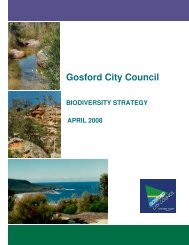Gosford City Council Historical Water Quality Review & Analysis
Gosford City Council Historical Water Quality Review & Analysis
Gosford City Council Historical Water Quality Review & Analysis
Create successful ePaper yourself
Turn your PDF publications into a flip-book with our unique Google optimized e-Paper software.
RESULTS OF WATER QUALITY DATA ANALYSIS 3-16<br />
The dissolved oxygen concentrations measured by the probe are difficult to interpret and are of<br />
limited value. The reason for this is the fact that the probe appears to have been affected by<br />
biological fouling. The results show a slow decline in dissolved oxygen concentrations between<br />
changeover periods. At changeover, the levels increase suddenly, indicating that prior to changeover,<br />
recorded levels were incorrect.<br />
Turbidity levels measured at Koolewong were highly variable, with values up to 160 NTU recorded<br />
regularly. A comparison of the turbidity and salinity plots indicated that higher turbidity levels were<br />
not always corresponding to catchment runoff events (as depicted by a reduction in salinity levels).<br />
Therefore, other factors also affect turbidity levels at the Koolewong datasonde. By way of example,<br />
it may be possible that wind waves cause resuspension of finer bottom sediments in the vicinity of the<br />
Koolewong probe. Also, the turbidity probe appears to be affected by biological fouling, with sudden<br />
reductions in turbidity occurring at instrument changeover (and coinciding with sudden changes in<br />
dissolved oxygen levels).<br />
3.2.2 Avoca Lagoon<br />
The results of the Avoca Lagoon datasonde show that the Avoca Lagoon entrance broke out 14 times<br />
between March 1996 and June 2002. On most occasions tides returned to the lagoon following<br />
breakout for a period of a few days before closing once again. When closed, water levels in the<br />
lagoon respond to periods of catchment runoff (with sudden increases in water levels) and<br />
evaporation from the water surface (with slow reductions in water level).<br />
In most cases, salinity follows a reverse trend to water level, with dramatic increases in salt<br />
concentration associated with entrance breakout, followed by a gradual reduction in salinity as the<br />
lagoon hydrology is subsequently dominated by freshwater catchment inputs.<br />
Temperature showed a strong seasonal trend, with temperatures peaking in January / February at<br />
about 25 – 30 °C, and reaching a minimum in June / July at about 10 – 12 °C.<br />
pH varied considerably within Avoca Lagoon, between about 7 and 9.5, although some values greater<br />
than 10 were also recorded. In general, higher pH levels appeared to occur during the early summer<br />
months (Oct – Dec) with levels generally about 9 or greater. Levels would then reduce to about 7.5<br />
during late spring / winter months. It is suggested that the pH levels within Avoca Lagoon are<br />
influenced by the seasonal cycles of phytoplankton and macroalgae growth. Although chlorophyll-a<br />
monitoring has not been conducted to measure the amount of primary productivity within the lagoon,<br />
it is likely that the increasing temperatures associated with the early summer months would initiate<br />
higher amounts of productivity in the waterway, resulting in increasing pH levels. When pH levels<br />
are elevated, entrance breakout can also have an impact on pH, as most of the phytoplankton and<br />
macroalgae would be removed or detrimentally affected by the sudden change in lagoon hydrology.<br />
Dissolved oxygen levels in Avoca Lagoon vary between 16 mg/L and zero. Oxygen levels can be<br />
influenced by several different factors in mostly closed lagoons, including phytoplankton and<br />
macroalgae growth (photosynthesis), organic decay (respiration), entrance breakout, and catchment<br />
runoff. The DO probe also shows some signs of biological fouling of the sensor, so all information<br />
derived from the data should be used with caution.<br />
D:\R.N0754.002.01.DOC 7/11/03 16:11
















